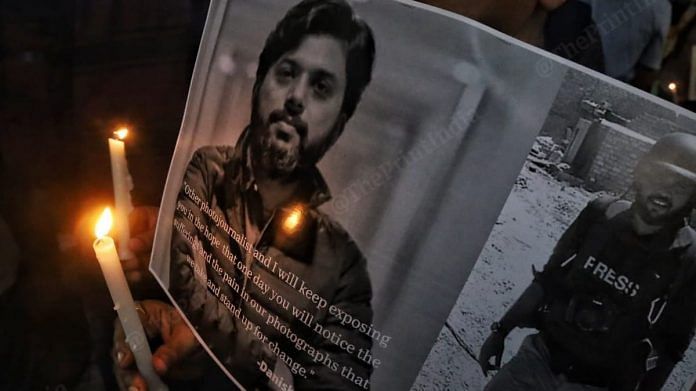New Delhi: Pulitzer-winning photojournalist Danish Siddiqui was killed after being left behind during a hasty military retreat while covering the conflict between Afghan government forces and the Taliban, a Reuters investigation has found.
The investigation also reviewed Reuters’ own protocol for sending journalists on dangerous assignments, and discovered no editor in the South Asia bureau was aware of Siddiqui being embedded with the Afghan special forces or the Spin Boldak mission he was on, during which he was killed.
In a report titled ‘Reuters photographer was killed after being left behind in retreat, Afghan general says’, the news agency published the findings of its investigation on its website Monday.
Siddiqui had been in Afghanistan for less than a week when the convoy he was travelling with came under fire from the Taliban. He was separated from the rest of the group in the fire, and in the confusion of the retreat, Siddiqui and two commandos were mistakenly left behind, Reuters has found.
A team of Reuters reporters — Stephen Grey, Charlotte Greenfield, Alasdair Pal, Reade Levinson and Devjyot Ghoshal — conducted the investigation and studied satellite images and photos captured by Siddiqui himself to piece together what happened.
They found that before he was killed, Siddiqui had sustained shrapnel injuries and sought refuge in a mosque where a medic treated him. A forensic expert who studied photos of Siddiqui’s body also confirmed he was shot multiple times after his death, and that it didn’t appear he had suffered any other kind of post-mortem injury.
In the weeks after Siddiqui’s death, reports had emerged that his body had been mutilated and run over by a vehicle. According to Reuters, Afghan and Indian officials said the body was mutilated post-mortem while in Taliban custody, charges the Taliban denies.
However, other circumstances surrounding Siddiqui’s death remain unclear, the report said.
For weeks, a small team of Reuters reporters – @stephengrey, @char_greenfield, @AlasdairPal, @readelev & I – worked to piece together the sequence of leading up to Danish's death.
We interviewed dozens of people, studied social media, satellite images and Danish's own pictures.
— Devjyot Ghoshal (@DevjyotGhoshal) August 24, 2021
Also read: Global media watchdogs, rights group demands probe into journalist Danish Siddiqui’s killing
Did bosses clear Siddiqui’s embedding with Afghan forces?
The investigation looked into Siddiqui’s correspondence with his editors and also whether the journalist was given the option to pull out, apart from Reuters‘ own vetting process of the situation in Afghanistan and the security protocols.
Interviews with managers and staff at Reuters as well as a review of Siddiqui’s email correspondence revealed that not a single editor in South Asia was part of the decision to embed him with the Afghan commandos and had no knowledge of the Spin Boldak mission Siddiqui was on.
It also discovered that three days prior to Siddiqui’s death, a Humvee he was travelling in was attacked. Given this fact, Krishna N. Das, a correspondent based in Delhi, asked, “Why was he allowed to go back in the embed? Why was he not pulled out of the deployment?”
However, photographer Goran Tomašević said, “If you get a chance to join a mission like this, you take it. The safest place to be quite often is with a group of soldiers like this,” according to the report.
People in the Reuters newsroom familiar the decision making said Siddiqui’s embedding with soldiers was vetted by external advisers and backed by senior photo editors, as well as newsroom managers who handle security.
This group included Editor-in-Chief Alessandra Galloni, Executive Editor Gina Chua who oversees security, and John Pullman, the global managing editor for visuals.
Galloni, in a letter to the staff dated 23 July, said she took full responsibility for the decision and called Siddiqui a “brilliant colleague and devoted friend”.
“I also know many of you want answers. We do too,” she further said, adding that a review process was under way and would include a “detailed examination of our security procedures”.
‘We already killed that guy’
From the accounts unearthed by the Reuters team, it appears that an Afghan special commando managed to contact a colleague who was with Siddiqui before his death. The phone, however, was answered by a Talib fighter who said: “You’re bringing Indians to fight against us.”
The officer replied: “Don’t shoot him. He’s a journalist.”
“We already killed that guy,” the Talib answered.
After his death, Siddiqui’s belongings were gathered by the bureau staff in Kabul. The Reuters investigation concluded its report saying: “His room there was left as any journalist in a hurry might leave it. Clothes and a towel lay on his unmade bed. Nearby were Bounty chocolate bars and cookies, a stab-resistant vest and a small suitcase containing his spare camera. Four weeks later, the Taliban occupied the capital.”
In the last 10 years, three Reuters journalists have been killed while on assignment. In the 10 years prior to that, 11 were killed.
(Edited by Manasa Mohan)
Also read: Real tribute to Danish Siddiqui is Indian journalists completing his Afghanistan stories



